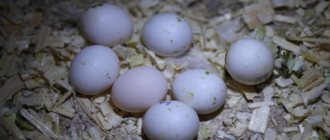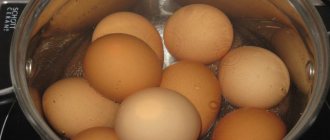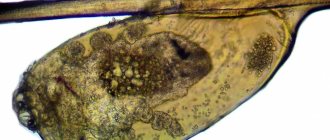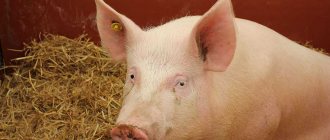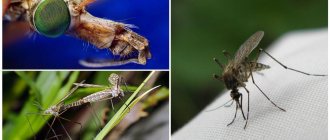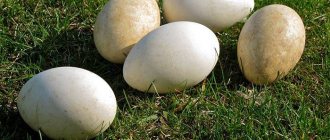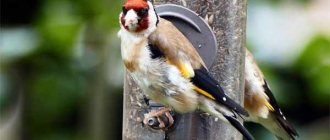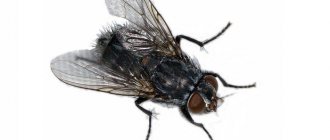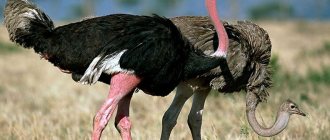Often people buy lovebirds for their home. They gained such popularity thanks to simple living conditions, bright plumage, activity and curiosity. Over time, the birds mature and create pairs. And now they need human help to create good conditions for the birth of healthy chicks. Let's look at how to properly make a nest for lovebirds, what conditions they need and how long lovebirds sit on their eggs.
Preparing to hatch eggs
Lovebirds are recognized by ornithologists as one of the best birds for captive breeding. They not only have beautiful bright plumage, but also adapt well to life in a cage. In order for breeding lovebirds at home to be successful, you need to listen to the advice of experienced breeders. Putting a pair of lovebirds in a separate cage and waiting for offspring is not enough; it is necessary to arrange a nest and help the babies to be born.
Nesting
First, a house is prepared for the birds to breed their offspring. You can make a wooden nesting box similar to a birdhouse. A nest box is also suitable - this is a trimmed tree trunk in which a depression is formed. There should be enough space in the nest for parents and offspring.
You can put a shallow plywood box in the cage. The bottom dimensions are 25 cm and 15 cm, the height is 20 cm. It is important to make a small recess for the masonry. Small tree branches scalded with boiling water should be placed inside. They should not be collected near roadsides. It is good to find nesting building material in the forest or garden. Soon the female will build a nest for lovebirds from small branches.
On a note. The main thing is not to forget about access for cleaning and disinfection of bird apartments. To do this, install a removable lid on the box. Before the nesting box is placed in the cage, it is disinfected and doused with boiling water.
The nest should not be kept in a cage all year round. It is installed in summer or autumn, depending on when the owner wants to get offspring. As soon as the lovebird chick becomes independent, the nest box is removed, otherwise the adults will begin to reproduce again. Repeated breeding of offspring over a short period of time exhausts their body; the young animals will turn out weak and unviable.
Nutrition
A week before the mating season, protein foods are introduced into the birds’ diet: eggs, cottage cheese, sprouted wheat. It is also necessary to diversify the birds’ diet with vegetables and fruits, and add chalk. Birds, especially females, need calcium during the nesting period.
Lighting
To stimulate the reproduction of lovebirds in captivity, the daylight hours are extended. In the evening, turn on a lighting device next to the cage for 15–20 minutes. The time is gradually increased. After 2 weeks the lamp should work 14 hours a day. This regime is observed throughout the breeding period. The birds will become active and noisy, begin to look after each other and look for secluded corners in the cage.
2 weeks are allotted for preparation; after this time, the birds will be ready for breeding.
Help in creating a nest
After making sure that the winged animals are ready to breed, you can install the breeding stand in the cage. At the same time, strict adherence to frequency is necessary - once every six months, so that the parrots are accustomed to the regime. You can control the amount of breeding by placing a breeding stand in a cage and removing it.
No matter how long it takes for birds to hatch eggs, they should feel comfortable in the nest.
The approximate dimensions of the reproduction box, in which the papagi will conveniently come out, look as follows: base - 160 × 160 mm, height - 250 mm; Possible deviations of 10-20 mm. The incubator diameter is 60 mm, better equipped with a distance of 25 mm from the lid.
Place the mainstream inside the bird's house. In a thick base, the 100mm diameter hole will be properly hollow, otherwise you will need to put in an egg bowl. The bottom should be evenly leveled with thin branches of willow, birch or linden. A pile of the same material must be placed in the cage so that the female can complete the slot.
Laying eggs
On the 7th or 10th day after mating, the female will lay her first egg. The next one will appear in a day or two. In total there will be from 4 to 7 eggs in the clutch. The female does not start hatching until there are 2 or more of them.
When breeding lovebirds in captivity and at home, you may encounter unforeseen situations. There are times when the female does not sit on the eggs. In this case, an incubator is needed. Perhaps the bird is still too young and its maternal instinct has not developed.
Inexperienced mothers may also lay eggs outside the nesting area. You just need to transfer them to the nest without touching them with your bare hands. Soon the bird will understand where to lay its eggs. When the first eggs appear, the question arises of how many days young lovebirds hatch their eggs. It all depends on the characteristics of each couple. But they still have certain deadlines for breeding their cubs.
How long do lovebird eggs hatch?
The duration of incubation in parrots is 20-26 days. However, the number can be higher or lower. At the same time, temperature indicators have virtually no effect on the duration of the process.
Differences may occur due to the individual characteristics of the pet. Moreover, during the breeding season you should not touch the clutch. Feeding and cleaning also need to be done carefully. Otherwise, the female may leave the nest. Parrots are very scrupulous in this matter.
What conditions must be created for comfortable incubation of offspring?
In order for a lovebird chick to be born healthy and viable, it is necessary to create comfortable conditions for its parents. It is important to monitor the humidity in the nest. It should not fall below 50%, ideally 60%. If the air in the room is dry, you can spray water in the corners of the nest. This is done so that the egg shells do not dry out and it is easier for the chicks to break them.
On a note. The air temperature in the room should not fall below 20 °C. When the mother leaves the nest, the eggs should not become too cold.
During the period when lovebirds hatch eggs, you must do the following:
- Ventilate the room without creating drafts. Birds need access to clean air for proper development.
- While the eggs are hatching, you should not distract your pets or look into the nest. Cleaning is done when the parents leave to eat and drink.
- Change the litter once a week. At the same time, it is not recommended to touch the masonry with bare hands.
- The water in the drinking bowl is changed every 2 hours. It must be boiled or bottled.
- The food should also not stagnate; the leftovers should be removed immediately and fresh food should be added to the feeder.
- All poultry dishes are washed thoroughly and doused with boiling water once a day. It is necessary to observe hygiene rules especially strictly during this period.
These factors determine how many healthy chicks the lovebirds will hatch. It is important that all embryos develop correctly and the babies hatch within the allotted time frame.
Possible problems
There are a number of issues that arise when breeding lovebirds. Typical aspects will be discussed below.
Chicks don't hatch
Reasons include:
- The eggs were not fertilized.
- There is more than one female in the nest.
- The bird is not capable of reproduction.
Lovebirds.
Checking for infertility of lovebird eggs. Measures:
- Remove an infertile parrot.
- Change the old male.
Incubation
Once all the eggs have been collected, the female sits on them. It is impossible to say exactly how many days lovebirds sit on eggs, everything is individual. But there are certain time periods in which offspring appear: from 3 to 4 weeks, 27 days is the deadline. Often the male also incubates the offspring, being distracted only to fly off to get food for the female. To obtain healthy offspring, it is important how many days domestic lovebirds will hatch eggs. If 27 days have passed and the egg has not hatched, most likely the embryo has died.
Before freeing itself from the shell, the chick pecks at the egg and makes a small hole to breathe. Within 24 hours he will be born.
Inseparable parrots hatch and raise their offspring together. They give babies digested crop food for 2 weeks. Afterwards the chicks begin to feed themselves.
Caring for chicks
In the first few days of life, the female feeds the chicks with her own secretion - goiter jelly. But already on the 5th–6th day, the babies’ diet is replenished with semi-digested food brought by the male parrot. Over time, the chicks switch to adult solid food. The young offspring gains complete independence by the end of the second month and leaves the nest.
If for some reason the female cannot feed the chicks, this responsibility falls on the shoulders of the owner. For complementary feeding, milk wheat or semolina porridge can be prepared. Chopped vegetables and fruits can be added in small quantities. The easiest option is to buy a ready-made composition at a pet store.
Young animals
Newly hatched chicks are completely helpless. They bear little resemblance to their handsome parents. Their red body is devoid of fluff, and their eyes do not open. They don't stand on their paws. However, within 2 hours after birth they can feed. At first, the mother feeds them with goiter milk. The male brings grains to the female, and she, digesting them, feeds the offspring. After 2 weeks, both parents begin to feed the babies.
Nutrition
At this time, the diet of adults should consist of grain porridge, millet wheat, and boiled chicken eggs. For about 90 days, parrots work to incubate and feed their offspring. This is a long and difficult period in their life, so they must receive complete and balanced food.
Development
Only after 10 days will the lovebird chicks open their eyes, and their bodies will be covered with bright fluff. After 24 days, their flight and tail feathers will grow. After a month, the young parrots will be fully feathered. 40 days after birth, young lovebirds begin to fly out of the nest. But parents will still feed their foolish offspring for 2 weeks. This completes the process of breeding lovebirds in simple home conditions. For the next six months, the birds can rest, recover and prepare for the next clutch.
Weight
Newborn chicks weigh 1 g, after 2 days - 2 g. At the end of the first month of life, the birds will weigh the same as their parents. After the young leave the nest and begin to move vigorously, their weight will decrease slightly.
For lovers and breeders of domestic parrots, breeding lovebirds in captivity is a labor-intensive process, but very interesting. If you create comfortable conditions for motley birds, you can get up to 7 nimble babies in one mating season. It is important to provide timely support to young parents and their helpless offspring at first.
Birds from the same brood or family
The pair of birds must be purchased from different nurseries or from different breeders. Close-up of a young parrot may not become popular parrots. This threatens various complications:
What happens is that the egg appears in the cage of the only parrot living at home. Due to the difficulty of determining gender, such an event makes it possible to clearly determine that the gender is female.
This is not surprising: just like chicks, the female parrot lays eggs without an embryo (because fertilization has not occurred). These eggs are homogeneous and slightly transparent.
Many budgies believe that the bird does not lay eggs if there is no nest in the cage. In fact, she can use the "furniture" of the cage, and in a cage she can use the "furniture of the cage" (toys, feeders) to nest or lay eggs on the bottom of the cage.
Long daylight hours and excess protein food are the most common stimuli for the laying of eggs in one female. Egg laying is very tiring for parrots and should be stopped as soon as possible.
There are different ways to stop the egg laying process caused by hormonal imbalance.
We suggest you read: Breeding Siberian kittens: characteristics of the breed, care rules, photos of cats.
The main task of the owner before the start of ovulation of a female parrot is to stop ovulation as quickly as possible. This is necessary for the health and life of the animal.
Nest arrangement and general information on breeding lovebirds
You shouldn't sit and just wait for your birds to give birth. Many parrots will probably be happy to have a nest in their cage. Build your pair of parakeets a small nest inside their cage.
However, this will not be the only problem you will have to deal with. At the same preparatory stage, make sure that your feathered pet’s diet is more varied. To do this, it will be enough to feed tamed lovebirds with certain portions of such feeding as boiled eggs, cottage cheese and sprouted grain.
Some ornithologists advise to slightly increase the length of the bird's day during this period of time. They do this in a very unusual way, placing a source of daylight near the cage.
In the evening, thanks to the light source, the length of daylight artificially increases. Lovebirds should respond to this change with increased mobility. Additionally, the amount of noise your birds make should increase.
The entire preparatory stage described should take about two weeks, after which it can be considered that your pets are ready for breeding.
